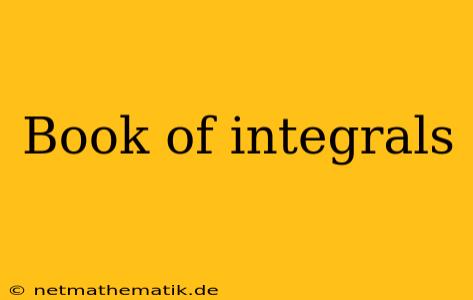The Book of Integrals, also known as a Table of Integrals, is an invaluable resource for mathematicians, scientists, engineers, and students who frequently encounter integrals in their work. These books compile a comprehensive collection of indefinite and definite integrals, along with their corresponding formulas and derivations. They serve as a reference guide, providing readily available solutions to common and complex integrals, eliminating the need for tedious manual calculations. This article explores the significance of Book of Integrals, their uses, types, and some notable examples.
Understanding the Importance of a Book of Integrals
The importance of a Book of Integrals lies in its ability to expedite the process of evaluating integrals. Integrals are fundamental to calculus and appear in numerous fields, including physics, engineering, economics, and statistics. They represent the accumulation of quantities over a range of values and are used to solve problems related to area, volume, work, and other concepts.
While basic integrals can often be solved using standard integration techniques, complex integrals can be time-consuming and challenging to solve manually. This is where a Book of Integrals comes into play. By providing a comprehensive list of pre-calculated integrals, these books streamline the integration process, allowing users to focus on applying the results to their specific problems.
Types of Integrals Found in Book of Integrals
Books of Integrals typically contain a wide range of integral types, including:
- Indefinite Integrals: These integrals are represented by the symbol ∫f(x) dx and represent the family of functions whose derivative is f(x).
- Definite Integrals: These integrals have upper and lower limits of integration and represent the area under the curve of f(x) between those limits.
- Trigonometric Integrals: These involve trigonometric functions like sine, cosine, tangent, and their inverses.
- Logarithmic and Exponential Integrals: These involve logarithmic and exponential functions.
- Rational Functions: These integrals involve polynomials divided by polynomials.
- Special Functions: These integrals involve functions that are not easily expressed in terms of elementary functions, such as Bessel functions, gamma functions, and elliptic integrals.
Common Uses of Book of Integrals
Books of Integrals find applications in various fields:
1. Mathematics: Mathematicians use Book of Integrals to solve complex problems involving integration, differentiation, and differential equations. They are essential tools for research and teaching in areas like calculus, real analysis, and complex analysis.
2. Physics: Physicists utilize Book of Integrals to solve problems related to motion, energy, work, and other physical phenomena. They are particularly helpful in fields like classical mechanics, electromagnetism, and quantum mechanics.
3. Engineering: Engineers rely on Book of Integrals to analyze and design structures, machines, and systems. They are used in fields like civil engineering, mechanical engineering, electrical engineering, and aerospace engineering.
4. Economics: Economists employ Book of Integrals to model economic phenomena like demand, supply, and growth. They are used in areas like microeconomics, macroeconomics, and econometrics.
5. Statistics: Statisticians utilize Book of Integrals to calculate probabilities, moments, and other statistical measures. They are essential tools in areas like probability theory, statistical inference, and data analysis.
Notable Examples of Books of Integrals
Several renowned Books of Integrals have been published over the years, each offering unique features and benefits. Some notable examples include:
- "Table of Integrals, Series, and Products" by I.S. Gradshteyn and I.M. Ryzhik: This comprehensive book contains an extensive collection of integrals, series, and products, along with their derivations and references. It is widely regarded as a standard reference for mathematicians, scientists, and engineers.
- "Handbook of Mathematical Functions with Formulas, Graphs, and Mathematical Tables" by Milton Abramowitz and Irene A. Stegun: This handbook provides a wealth of mathematical information, including a substantial section dedicated to integrals, series, and special functions. It is a valuable resource for scientists and engineers working in various fields.
- "CRC Standard Mathematical Tables and Formulae" by Daniel Zwillinger: This comprehensive reference book offers a broad range of mathematical formulas, tables, and graphs, including a section on integrals. It is a handy resource for students and professionals in various fields.
Conclusion
Book of Integrals are invaluable tools for professionals and students who encounter integrals in their work. They provide a comprehensive collection of pre-calculated integrals, eliminating the need for tedious manual calculations. Whether solving complex problems in mathematics, physics, engineering, economics, or statistics, Book of Integrals serve as essential references, streamlining the integration process and facilitating deeper understanding and application of integrals in various fields.
